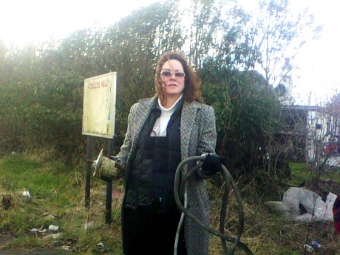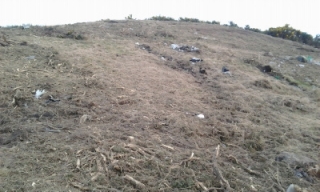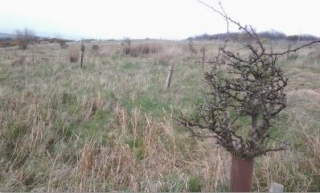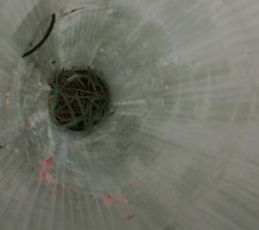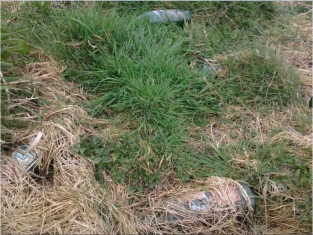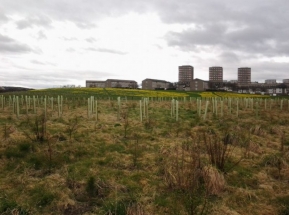Old Susannah looks back at the week that was and wonders who’s up to what and why. By Suzanne Kelly.
Old Susannah is having trouble sleeping at the moment for several reasons. Firstly, there is the sheer excitement over the UTG design competition – which design will I fall in love with? What will be built that will make the world beat a path to Aberdeen for coffee, baguettes and monorail rides? Will Paris, New York and Rome empty as people come to Union Square and the new UTG?
Secondly, I am worried about Ms Aileen ‘Homalone’ who has dropped out of the public eye, and refuses (to date) to answer questions about the finances needed for the phase 2 attempt to plant trees on Tullos, and the money to shoot those extremely hungry deer. It looks as if there isn’t any money, but no one’s talking to the public just now.
I did email to say ‘C’mon Aileen’ – and she replied that ‘an officer (if not a gentleman) would get back to me’.
I gently reminded Homalone that she had at least a little responsibility for the scheme to rid Tullos of vermin deer and plant 89,000 trees where trees had failed before, as she’d taken a wee bit of the public relations credit for this great scheme to begin with. I expect as soon as she turns her razor-sharp mind to the task of analysing all the facts and figures regarding the tree planting, deer and slaughter, she’ll revert to me asap.
I don’t think I’ll hold my breath though.
You may recall the deer are under the death sentence because we must be cheap when using ‘the public purse,’ and Aileen being a good Lib Dem can’t stand any waste of public money. Quite right.
No such restrictions apply to buying crucial carriage clocks and expensive pens from the Common Good Fund.
If you are in Inverness, you have to apply to use the common good fund there, and a committee decides if your charity should get a bit of the fund. They seem to have helped quite a number of deserving causes, and the application procedure is the same for the rich and the poor, believe it or not. It is not quite as easy to get a handle on who has their fingers on Aberdeen’s CGF sporran strings. But I digress – again.
Thirdly, I can’t sleep now that I know it’s OK to shoot small mammals and birds on Tullos Hill whenever you want – you just need a permit and the right kind of gun. I am amazed that no one’s been shot there yet. I am also amazed that people still like to hunt living things, but I guess I need to acknowledge that the law allows this.
So do keep walking on Tullos, but keep in mind bullets can travel long distances, and wear your bright clothes and your bulletproof vest. And for goodness sake, don’t wear any of those novelty deer antler headbands.
Vermin:
(noun) 1. insects such as lice, ticks or fleas (or the more fashionable bedbugs plaguing New York at present) which can lead to infestations. 2. birds and mammals that eat other animals / game. 3. animals which are after the same food as people or domestic animals (How dare they!).
The police sent me some detailed answers about the gunman spotted on Tullos Hill in early September after I did one of my little FOI requests. The hunter would not legally have been after the roe deer – but the police made it clear that such ‘sportspeople’ are allowed to shoot ‘vermin’. The police definition of what constitutes vermin seems to include deer. So the next time you and a roe deer are trying to nibble the same 2,000 trees, just kill it – as long as you have a permit and are using the right kind of bullets and rifle. Result!
But if the deer aren’t after the same quarter-pounder you want, and the squirrels (red, black, grey – I don’t discriminate) aren’t after your chocolate shake – then are they really vermin? The vermin label put on these wild animals justifies the gamekeeper poisoning the birds of prey, the snare-setter (snares are still legal for some reason) who kills indiscriminately, and the council targeting the Tullos Hill deer.
Speaking of the council (well some of them anyway), I’d best move to another definition before someone comes gunning for me. And for some reason, a related word comes to mind now that I’ve mentioned our City Council.
Parasite:
(noun – English ) an insect or other creature which feeds off of a host animal to the host’s detriment.
Let’s consider bloodsuckers, worms, leeches and ticks. These are some of the parasitic vermin infesting your city council. You do have the right ammo to despatch them – or at least you will come May elections with your vote. The parasites in question feed of resources such as The Common Good Fund, Council Taxes and all-expense paid hospitality.
Like a swarm of locusts, they descend on areas such as the AECC and the Beach Ballroom if so much as a free sandwich can be had. Parasites such as these are notoriously thirsty, and can empty cases of drink in nanoseconds.
Do not get too close to such creatures – they may well carry disease. Do instead hide your money (offshore if possible), and guard any green spaces, which these parasites can easily destroy if not kept in check.
“Cultural” spaces:
(noun, English Modern) a wholly new concept of “space” where “Cultural” “events” can take place. Not to be confused with existing businesses or arenas and spaces they have for cultural events.
If it’s not hard enough for me to get any sleep with everything else going on, the Evening Express told us on 8 October that there is a ‘plan’ to attract ‘top performers (!)’ to Aberdeen. This brand-new idea, never before attempted, would see the ‘proposed new park over (?!!) Union Terrace Gardens’ filled with “cultural” spaces. (By the way, the quotes around the word “cultural” appear in the Evening Express piece on this subject, so I’d better leave them in).
“Culture” of course is something that we people not in ACC, ACSEF, or SEG can’t really appreciate or understand. ( Remember – Stewart Spence, stalwart of the Marcliffe wrote to the P&J last week to call people opposed to these great new plans ‘NIMBYS and luddites’. Who can argue with him?).
The AECC – long propped up by the taxpayer – and the Lemon Tree (likewise on a taxpayer sub) have never attempted to bring Top Performers here before. Likewise none of the independently-owned bars and clubs (not supported by taxpayers by the way) have tried this either. Some years ago I got my hopes very high about Top Performers coming here, but in the end, Geri Haliwell had to pull out of doing the AECC.
Now in another guise, Scottish Enterprise might not really be permitted to shell out large amounts of taxpayer cash to create “cultural” spaces if these new inventions borne of taxpayer money would compete with already-existing public funded and/or private spaces.
But the story with UTG is different somehow – kind of like when Scottish Enterprise took the money the Arts Council had earmarked for Peacock (who had wanted to , er, create a “cultural” space in UTG first). Hmm – I must remember to soon define ‘intellectual property’, ‘copyright’, ‘lawsuit’ and ‘moral rights’.
I for one am happy to subsidise the AECC directly and indirectly (the City Council somehow needs to rent large amounts of office space at the AECC despite its large roster of properties) as well as subsidise the other city-owned venues AND find some 140 million towards yet another “cultural” space under/in/over Union Terrace Gardens. And if the private sector of the music/entertainment industry in Aberdeen can’t compete, then that’s just showbusiness.
We are in a democracy after all – the richest amongst us get to either be on boards or appoint boards to do what they want done with public spaces – all in the name of “culture”.
If we don’t ‘get it’, then we are indeed the NIMBYS and luddites Spency thinks we all are. I shall remember his words when I next book a dinner or a hotel.
Those who oppose the UTG project (not that it is defined yet – not even Old Susannah could do that if the city can’t) will be laughing out of the other side of their faces when I’m having a large latte before Toto opens up for Geri Haliwell near the monorail at the Wood memorial car park “cultural” space centre. So there. Gives those luddites something to think about doesn’t it?
I have to digress again – it is because some of us can’t understand how wonderful the whole project is that we oppose it. It is all crystal clear, but here is a little helpful guide as to who’s doing what about our “culture” space / UTG project. Here is my little luddites guide to the simple way things work
1. Locum Consultants – apparently a part of the Collier Group – have been hired to ‘find uses’ for ‘some kind of performance and exhibition space’ created by the UTG project. Appointed (by whom I don’t know).
(By the way I can find a ‘Locum Consultants’ in Surrey and a ‘Collier International’ in Manchester. Unless there are companies with those names in Scotland, I guess no one here was up to the job of filling the “cultural” space. I could be wrong, I could be right).
2. The Aberdeen City Gardens Trust (ACGT) – works on ‘how to use “cultural” spaces inside (?!!) the proposed new park over Union Terrace Gardens’. Unelected. (This seems to be a “Private, Limited by guarantee, no share capital, use of ‘Limited’ exemption” kind of an affair – which makes sense as the Taxpayer is paying for it at least in part, and it will be involved in the future of a public asset. Result!) Or in words a child could understand – taken from the website: http://thecitygardenproject.com/news
“Aberdeen City Gardens Trust has been set up, under the auspices of the City Garden Project management board, as a special purpose vehicle to channel funding for the project and deliver key activities within the project plan. The Trust will operate using best practice procurement procedures and will be accountable for the delivery of activities to project management board.
“The Trust will also receive £375,000 of Scottish Enterprise funding from its available funds for major infrastructure projects.
“Cllr John Stewart, chairman of the City Garden Project management board, said: “The fact that Aberdeen City Council is making no revenue contribution to the project means it is necessary to be imaginative in the way in which non-council finance levered into the project is managed. The creation of the Trust presents us with an ideal solution. Equally, it will allow for contracting of the required services involved in the next steps and for the project to progress to the design competition stage and complete the business case for the TIF application. Through the TIF we will be to access funding not otherwise available to invest in the art gallery and the St Nicholas House site, enhancing and reinvigorating our city centre.”
“The founding directors of the Trust are Tom Smith and Colin Crosby who will be joined by Directors from Aberdeen City Council and others involved in the project in due course”.
3. The City Gardens Monitoring Group – exists to hide its doings and to decide that the public should not vote on the option of leaving the gardens as they are in the current design competition for the 6 finalists (chosen by an unelected group and guaranteed loads of dosh for getting this far). The Group redacted its minutes to the point you had no idea who was in it (unless you cut and pasted the redacted text and found none other than Aileen Malone was involved). Unelected.
But for those of you still not clear, here is an excerpt of who’s who and who’s doing what where from our City’s very own website: http://www.aberdeencity.gov.uk/
“The membership of the Project Monitoring Group comprises Councillors Malone (Chair), Boulton, McDonald, Kirsty West, Wisely, Young and Yuill.
“For reference, the membership of the City Garden Project Management Board comprises Councillor John Stewart (Chair), Councillor Callum McCaig and Valerie Watts, ACC; Tom Smith and Colin Crosby, ACSEF; Jennifer Craw, the Wood Family Trust; Bob Collier, Aberdeen and Grampian Chamber of Commerce; John Michie, Aberdeen City Centre Association; Lavina Massie, the Aberdeen City Alliance, Maggie McGinlay, Scottish Enterprise and Paul Harris, Gray’s School of Art.
“The membership of the Project Implementation Team comprises Tom Smith (Chair), Colin Crosby and John Michie, ACSEF; Gerry Brough, Hugh Murdoch and Patricia Cassidy, ACC; Jennifer Craw, the Wood Family Trust; Maggie McGinlay, Scottish Enterprise; Derick Murray, Nestrans; Audrey Laidlaw, Network Rail and Iain Munro, Creative Scotland”.
This diverse membership of people with no vested interests in the project going ahead or not will reassure us all. But somehow, I still can’t get any sleep.
4. Malcolm Reading – a design consultancy which shortlisted the winning entries in the design competiton, an amazing feat, as there was and is no design brief in existence approved by ACC. What Malcolm Reading will earn is unknown; how exactly it was appointed is also a mystery to me.
5. The BIG Partnership – a PR consultancy which tells us how great it all is going to be. I don’t know how they were appointed or what they will earn. (not to be confused with ‘The Big Sleep’.) STOP PRESS: The BIG Partnership has recently announced a new client: The Wood Family Trust.
6. ACSEF – A board of business people and city officials who, well, do what they like. Includes one impartial Mr S Milne. Known for issuing warning as to dire consequences for Aberdeen if we don’t build on the garden. ACSEF is an invention of ACC, and funded at least in part by the public purse which we are all so keen to use sparingly.
7. Genus Loci – a document produced supporting ideas for the Garden’s future as long as these don’t include a garden for the future. Famous for proposing the monorail idea.
8. Scottish Enterprise – a quango, unelected, on a mere £750 million or so per year which holds meetings, and supplies members to sit on the board of ACSEF, and who gave the world Jennifer Craw, now on the Wood Family Trust. Which of course has a seat or seats on the secretive City Gardens Monitoring Group – or was it the Aberdeen City Gardens Trust. Unelected and expensive.
9. Wood Family Trust – er, apparently the wood family and/or friends who want to get rid of the wood in the gardens apparently, for “cultural” spaces. Apparently not elected. This Trust has possibly one or two overlapping areas with some of these other groups, maybe.
10. Project Implementation Team – are on hand to implement the project whether or not the public want them to.
Now that you see how simple it all is, I trust that there will be no more whining about the expense of paying all these companies off, signing a lease for a few thousand years for the gardens, or whinging about issues of ‘transparency’.
As that little Meerkat person on TV would say, ‘Simples’.
I was going to define ‘Impartiality’ this week as well, and how it relates to TIF, BID, and so on. However, I now have a headache for some reason, and there is a knock on my door which may be the sherrif coming for my furniture. ‘Impartiality’ it is for next week then. And ‘Old Boys’ Network’, ‘Nepotism’ and ‘Greed’.
Good night all.
